
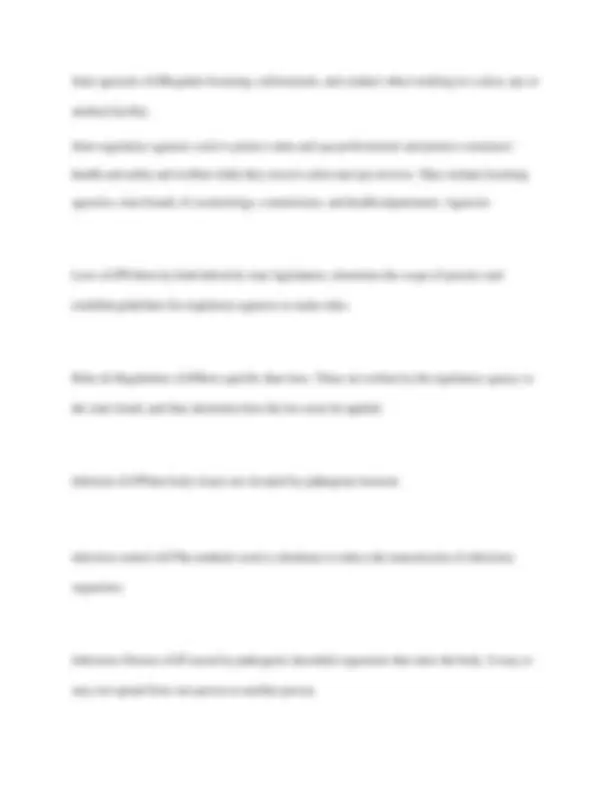
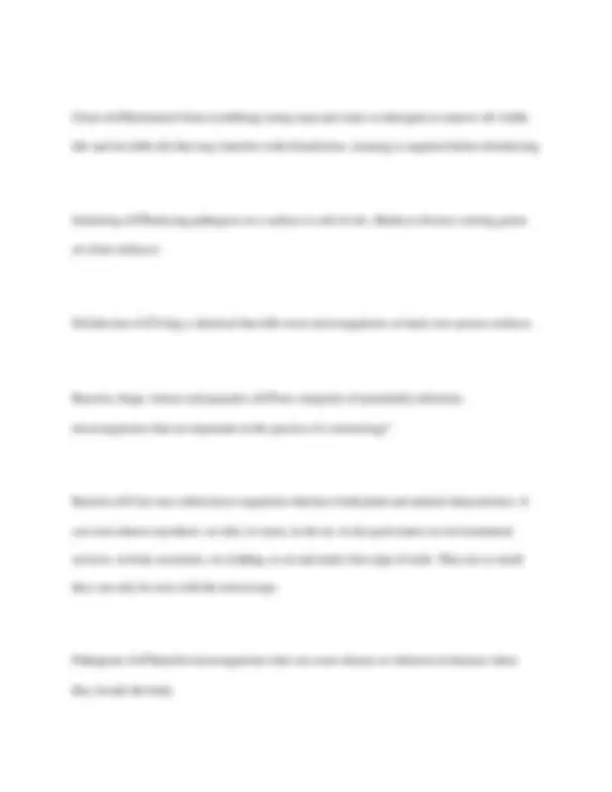
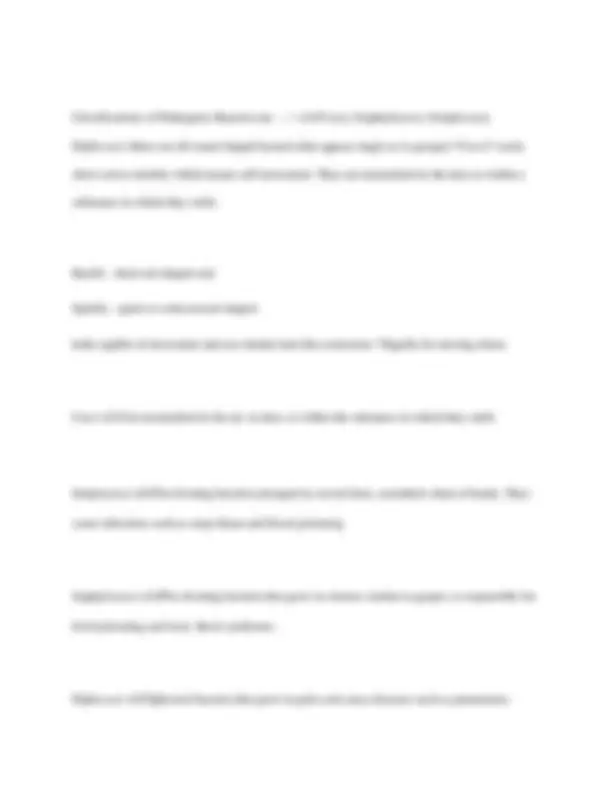
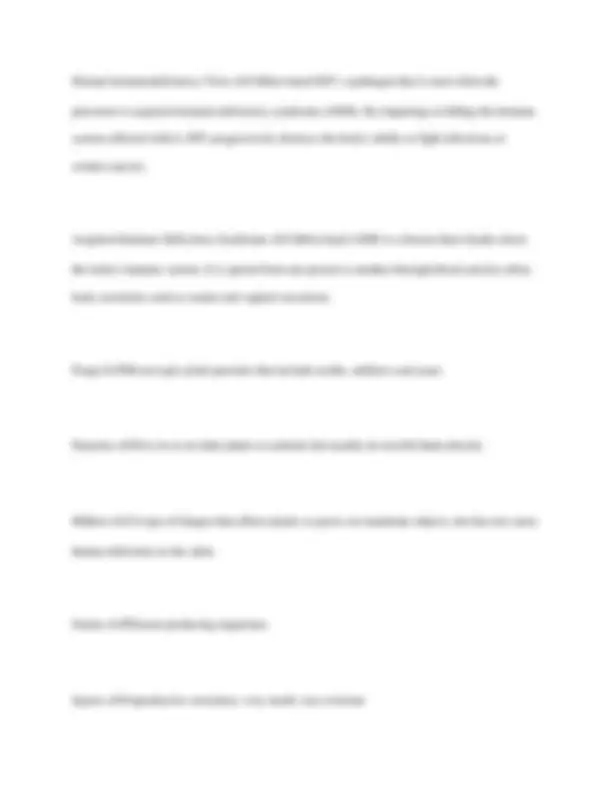
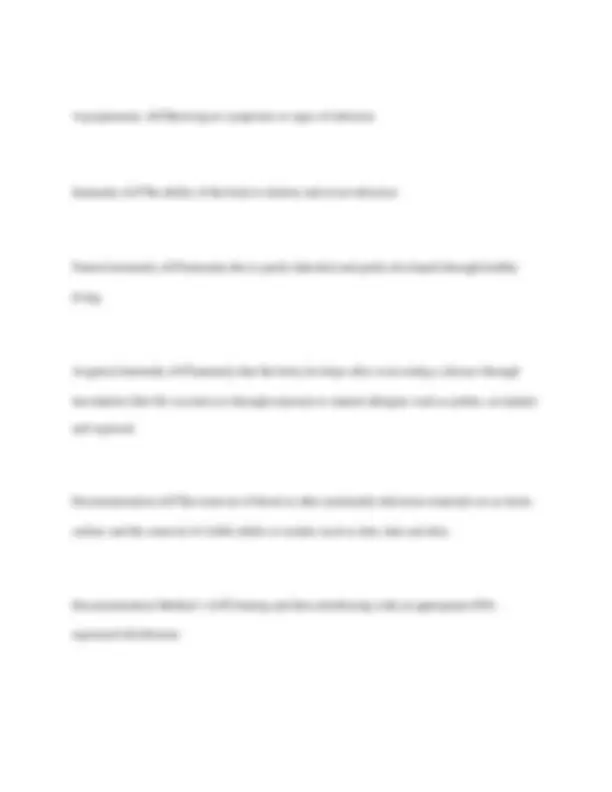
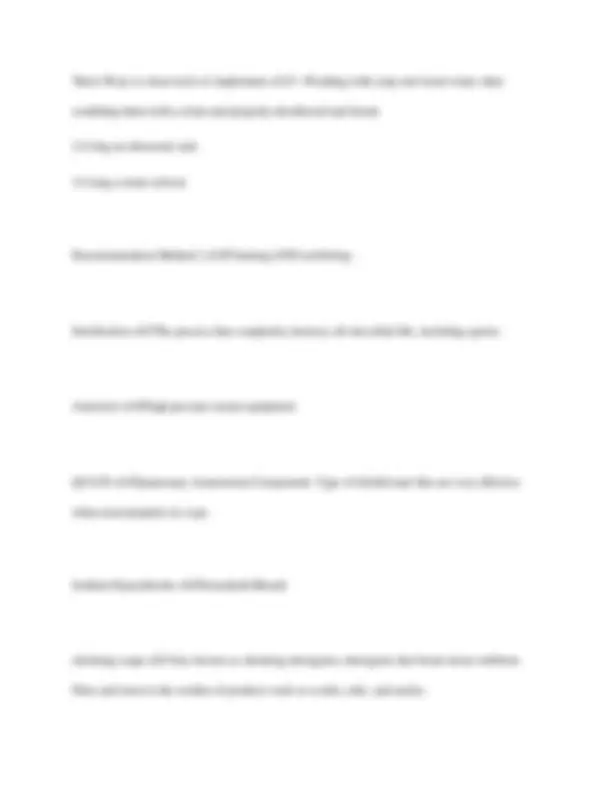
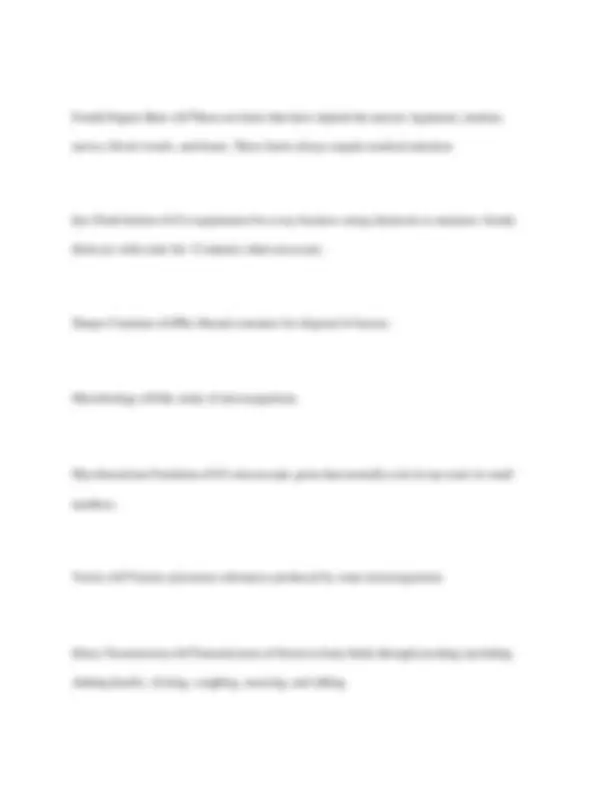
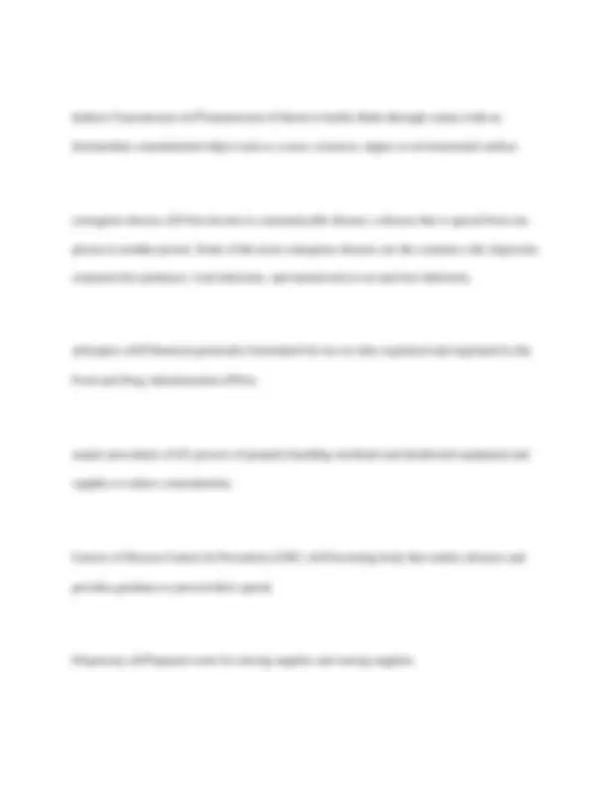


Study with the several resources on Docsity

Earn points by helping other students or get them with a premium plan


Prepare for your exams
Study with the several resources on Docsity

Earn points to download
Earn points by helping other students or get them with a premium plan
Community
Ask the community for help and clear up your study doubts
Discover the best universities in your country according to Docsity users
Free resources
Download our free guides on studying techniques, anxiety management strategies, and thesis advice from Docsity tutors
Esthetician State Board Written Study Guide (Texas) ~Sanitation, Disinfection, and Safety Already Passed
Typology: Exams
1 / 14

This page cannot be seen from the preview
Don't miss anything!









Federal agencies ✔✔Set guidelines for the manufacturing, sale, and use of equipment and chemical ingredients along with safety in the work place.
OSHA ✔✔Occupational Safety and Health Administration -
Occupational Safety and Health Act was passed by Congress to encourage job safety (hazards of materials, mixing, disposing, storing ) created as a part of the U.S. Department of Labor to regualte and enforce saftely and health standards to protect employees in the workplace ~ page 75 Milady~
EPA ✔✔Environmental Protection Agency - registers all type of disinfectants sold and used in the US.
Disinfectants ✔✔Chemical products that destroy all bacteria, fungi and viruses (but not spores) on the surfaces.
Tuberculocidal and hospital strength ✔✔Two strengths of disinfectants used in salons and spas.
Hospital disinfectants ✔✔Effective for cleaning blood and bodily fluids. Can be used on nonporous surfaces (non absorbing)
Tuberculocidal disinfectants ✔✔Proven to kill the bacteria that cause tuberculosis. Much more powerful but can be harmful to salon, spa and estetic tools (require special methods of disposal)
MSDS ✔✔Material Safety Data Sheet-
Both Federal and state laws require that manufacturers supply a MSDS for all products sold. It contains information compiled by the manufacturer about the product safety including the names of hazardous ingredients, safe handling, and use of procedures, precautions tp reduce the risk of accidental harm or over exposure and flammability warnings. MSDS also provides useful disposal guidelines and medical and first aide information. OSHA and state regulatory agenices require that MSDS be kept available in the salon or spa ore medical office at all times.
Nonporous ✔✔Items that are made or constructed of a material that has no pores or openings and cannot absorb liquids.
Clean ✔✔Mechanical form (scrubbing) using soap and water or detergent to remove all visible dirt and invisible dirt that may interfere with disinfection. cleaning is required before disinfecting
Sanitizing ✔✔Reducing pathogens on a surface to safe levels. (Reduces disease causing germs on clean surfaces)
Disinfection ✔✔Using a chemical that kills most microorganisms on hard, non-porous surfaces.
Bacteria, fungi, viruses and parasites ✔✔Four categories of potentially infectious microorganisms that are important in the practice of cosmetology?
Bacteria ✔✔Are one-celled micro-organisms that have both plant and animal characteristics. It can exist almost anywhere: on skin, in water, in the air, in decayed matter on environmental services, in body secretions, on clothing, or on and under free edge of nails. They are so small they can only be seen with the microscope.
Pathogenic ✔✔Harmful microorganisms that can cause disease or infection in humans when they invade the body.
Classifications of Pathogenic Bacteria are ----> ✔✔Cocci, Staphylococci, Streptococci, Diplococci (these are all round shaped bacteria that appear singly or in groups) Cocci rarely show active motility which means self movement- They are transmitted in the dust or within a substance in which they settle.
Bacilli - short rod shaped and
Spirilla - spiral or corkscrewed shaped
both capable of movement and use slender hair like extensions *flagella for moving about.
Cocci ✔✔Are transmitted in the air, in dust, or within the substance in which they settle.
Streptococci ✔✔Pus forming bacteria arranged in curved lines, resembels chain of beads. They cause infections such as strep thraot and blood poisining
Staphylococci ✔✔Pus-forming bacteria that grow in clusters similar to grapes; is responsible for food poisoning and toxic shock syndrome.
Diplococci ✔✔Spherical bacteria that grow in pairs and cause diseases such as pneumonia.
MRSA ✔✔ethicillin-Resistant Staphylococcus Aureus- a type of infectious bacteria that is highly resistant to conventional treatments such as antibiotics.
Contagious Disease ✔✔Also known as communicable disease - Is when a disease spreads from one person to another. examples are- common cold, ringworm, pink eye, viral infections, nail or toe infections. They are mostly spread through dirty hands (under the nails) They can also be spread through contaminated implements cuts, infected nails, open sores, pus, mouth and nose discharge, shared drinking cups, telephone receivers and towels.
Virus ✔✔A parasite submicroscopic particle that infects and resides in cells of biological organisms. Capable of replication only through taking over the host cells reproductive function
Bloodborne Pathogens ✔✔Disease-causing microorganisms carried in the body by blood or body fluids, such as hepatitis and HIV
hepatitis ✔✔A bloodborne virus that causes disease and can damage the liver.
Human Immunodeficiency Virus ✔✔Abbreviated HIV; a pathogen that is most often the precursor to acquired immune deficiency syndrome (AIDS). By impairing or killing the immune system affected with it, HIV progressively destroys the body's ability to fight infections or certain cancers.
Acquired Immune Deficiency Syndrome ✔✔Abbreviated AIDS is a disease thats breaks down the body's immune system. It is spread from one person to another through blood and less often body secretions such as semen and vaginal secretions.
Fungi ✔✔Microscopic plant parasites that include molds, mildews and yeast.
Parasites ✔✔live in or on other plants or animals but usually do not kill them directly
Mildew ✔✔A type of fungus that affects plants or grows on inanimate objects, but doe not cause human infections in the salon.
Germs ✔✔Disease producing organisms
Spores ✔✔reproductive structures; very small; very resistant
Three Ways to clean tools or implements ✔✔1- Washing with soap and warm water, then scrubbing them with a clean and properly disinfected nail brush
2-Using an ultrasonic unit
3-Using a clean solvent
Decontamination Method 2 ✔✔Cleaning AND sterilizing-
Sterilization ✔✔The process that completely destroys all microbial life, including spores.
Autoclave ✔✔High pressure steam equipment
QUATS ✔✔Quaternary Ammonium Compounds. Type of disinfectant that are very effective when used properly in a spa.
Sodium Hypochlorite ✔✔Household Bleach
chelating soaps ✔✔Also known as chelating detergents; detergents that break down stubborn films and remove the residue of products such as scrubs, salts, and masks.
Goggles and Gloves ✔✔What should you be wearing when disinfecting implements.
Personal Protective Equipment ✔✔Abbreviated PPE; protective clothing and devices designed to protect an individual from contact with bloodborne pathogens; examples include gloves, fluid- resistant lab coat, apron, or gown, goggles or eye shield, and face masks that cover the nose and mouth.
single-use ✔✔Also known as disposable; items that cannot be used more than once. These items cannot be properly cleaned so that all visible residue is removed or they are damaged or contaminated by cleaning and disinfecting in exposure incident.
Multi Use ✔✔Also known as reusable; items that can be cleaned, disinfected, and used on more than one person, even if the item is accidentally exposed to blood or body fluid.
Cross-contamination ✔✔Contamination that occurs when you touch one object and then transfer the contents of that object to another, such as touching skin, then touching a product without washing your hands.
Fourth Degree Burn ✔✔These are burns that have injured the muscle, ligaments, tendons, nerves, blood vessels, and bones. These burns always require medical attention
Eye Flush Station ✔✔A requirement for every business using chemicals to maintain. Gently flush eye with water for 15 minutes when necessary.
Sharps Container ✔✔Bio Hazard container for disposal of lancets.
Microbiology ✔✔the study of microorganisms
Mycobacterium Fortuitum ✔✔A microscopic germ that normally exist in tap water in small numbers.
Toxins ✔✔Various poisonous substances produced by some microorganisms
Direct Transmission ✔✔Transmissions of blood or body fluids through touching (including shaking hands) , kissing, coughing, sneezing, and talking
Indirect Transmission ✔✔Transmission of blood or bodily fluids through contact with an intermediate contaiminated object such as a razor, extractor, nipper or environmental surface
contagious disease ✔✔Also known as communicable disease; a disease that is spread from one person to another person. Some of the more contagious diseases are the common cold, ringworm, conjunctivitis (pinkeye), viral infections, and natural nail or toe and foot infections.
antiseptics ✔✔Chemical germicides formulated for use on skin; registered and regulated by the Food and Drug Administration (FDA).
aseptic procedures ✔✔A process of properly handling sterilized and disinfected equipment and supplies to reduce contamination.
Centers of Disease Control & Prevention (CDC) ✔✔Governing body that studies diseases and provides guidance to prevent their spread.
Dispensary ✔✔Separate room for mixing supplies and storing supplies.